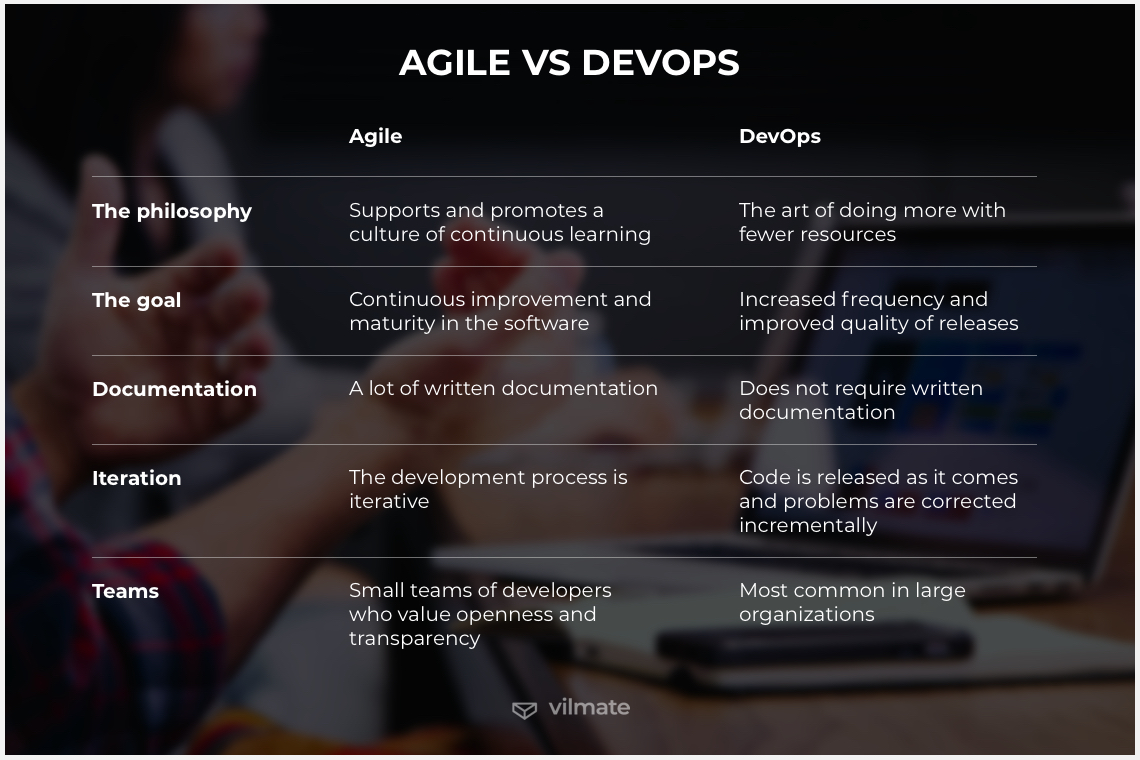As of today, Agile vs DevOps is a hotly debated topic where opinions vary widely. Their differences are not without common ground. But also they have a common underlying idea. Agile and DevOps both are an effective means for building highly productive teams of tech specialists. Using the two approaches together thus utilizing the best practices, skills, and techniques from the two worlds is a surefire way to the project success. The big question is whether or not there is a significant difference between DevOps vs Agile operations and, if so, by how much.
This post is a guide to capture the debate, highlighting key trends, takeaways, and where we're headed in 2020.
Difference between DevOps and Agile
One of the key differences between DevOps and Agile is that we expect the DevOps people to be intimately involved in building the software. As part of their project team duties, they're responsible for writing the code and moving it around. In turn, for an Agile team, it's not the software-building that makes a difference, but rather the process by which it is built.
At first glance, DevOps looks like the vision and Agile — like its execution. So, let's find out what each term indicates to see the difference between Agile and DevOps more clearly.

What is Agile?
The concept of Agile is used to describe a set of lean software development practices and values guiding an organization in how they run the project. Arguably, being agile means moving quickly, innovating quickly, and breaking new ground. Agile procedures are being executed using a number of frameworks like Scrum vs Kanban.
The relevant process is to prioritize, develop, implement, test, and repeat, which makes Agile culture easy to implement in a team of all different skill levels, from junior developers to senior technical leaders. Therefore, all project team members have an active role in the delivery of what they are collaboratively working on. The Agile methodology values authenticity, transparency, and collaboration. It also highlights the rapid change as part of the accelerated SDLC and is characterized by the following rules:
-
The philosophy. The biggest reason is that Agile is a philosophy that supports and promotes a culture of continuous learning, which brings about an incredibly high percentage of positive changes in the company. In its fullest, it’s embodied in the Agile Manifesto.
-
The goal. Unlike DevOps, Agile software development pushes for not exactly the boost in efficiency but rather the continuous improvement and maturity in the software. Agile practices ensure that decisions are not imposed by technical constraints. They promote flexibility and provide value to end-users.
-
Documentation. Agile methodologies — from lean to iterative — require a lot of written documentation that are detailed enough that even a newcomer can learn and understand them.
-
Iterations. In the first place, Agile practices shape a way in which organizations deliver software. They focus on making the development process iterative. So, Agile vs Scrum vs Kanban are thus the dimensions of the iterative process. In the case of Agile software development, the process moves from short to long iterations falling somewhere between the waterfall and the Kanban models.
-
Teams. Agile teams differ from DevOps teams in how they are structured and how they operate. Agile teams are normally small and consist of developers who value openness and transparency and use code reviews, peer review, and discussions. Their communication is enhanced by holding daily meetings and this helps all team members always remain up to date with what has been achieved and what is ahead.
What is DevOps?
The name "DevOps" has quickly become the go-to term for anyone contemplating an organizational shift to a more performance-oriented approach. If you consider DevOps "the software development process", then you will notice that the biggest difference is the systematic approach to developing and shipping code. The DevOps approach to software development emphasizes putting in efforts into keeping everything under control and tying together as many important services as possible in a package. Comparing Agile and DevOps, let’s take the criteria we discussed above and see how different they will be when put in the context of DevOps.
-
The philosophy. The biggest reason is that Agile is a philosophy that supports and promotes a culture of continuous learning, which brings about an incredibly high percentage of positive changes in the company. In its fullest, it’s embodied in the Agile Manifesto.
-
The goal. DevOps aims at aligning development and operations and organizing them in such a way to achieve business objectives in the optimal fashion. It focuses primarily on software deployment increasing the frequency and improving the quality of releases.
-
Documentation. DevOps has created a model that does not require written documentation because we can focus on implementation instead of on documentation.
-
Iterations. Modern development practices, DevOps and Agile among them, indicate a strong focus on easy iterations. On the other hand, DevOps involves the release of code as it comes and work is done to incrementally correct problems. This is a very different pattern that stands in stark contrast to Agile.
-
Teams. DevOps is a set of practices and principles intended to help development and operations work more effectively together. DevOps teams, by contrast, are most common in large organizations. Thus, DevOps becomes an excellent solution to teams’ finger-pointing at one another when working on the same project. The DevOps approach makes development, QA, IT operations, and management teams reconcile.
Agile vs DevOps - what do they have in common?
The similarity of Agile and DevOps gets visible when the issue of Waterfall vs Agile vs DevOps comes up. This comparison shows that although the two are not the same thing, they still have a lot in common.
A good analogy for Waterfall vs Agile vs DevOps is that Waterfall is a set of principles that help us simplify and organize our existing infrastructure and systems, while Agile is the principle that makes it easier to switch to a new framework or change our business processes, while DevOps is about making infrastructure scalable so that we can iterate more quickly on new ideas.
Basically, the waterfall is where the manager tells you, "After this, I'll show you what we did" and doesn't provide enough detailed steps towards that goal. Alternatively, Agile starts from the essence and builds a specific agenda for execution. And DevOps moves the focus to a specific set of tasks, usually assigned to a specific team member. So, unlike the waterfall model, both Agile and DevOps have the same concept of continuous improvement in their essence.

To be more specific, let’s look at the three things that give a new perspective to the Agile vs DevOps comparison making them look quite similar:
1. Security, durability, and testability
Both Agile and DevOps are actively seeking a stable, fast, quality-assurance environment in which to operate. Each has sought to achieve this through the integration of countless testing, certification and usability processes, with massive testing and analysis events, on a regular basis. They are alike in achieving the stability and quality of their own systems. Both Agile and DevOps cultures want to increase automation, so this is reflected in their strategies for providing safe, efficient, and continuous testing.
Agile approaches rely on automation to remove human barriers and allow more flexibility in the execution of the process, whereas DevOps aims to provide the security and remove the human-caused changes from the pipeline, which not only can take valuable time and effort to implement but will also be difficult and resource-consuming to correct.
2. Visibility
Making work visible is one of the key objectives of DevOps and Agile. Providing visibility to the development of software components for everyone involved results in the overall consistency of releases and therefore ensures efficient product delivery. Both Agile and DevOps emphasize interactions among individuals, collaboration, and responsiveness to change. To make it all possible, work in teams must be visible.
In Agile Scrum vs Kanban practices, information is shared on boards, so one can remain up to date, track all the activities undertaken, and pinpoint bottlenecks there. The same practices are used by development and operation teams in DevOps with the view to broadcasting information about functional and non-functional work to all team members. Besides, DevOps takes advantage of telemetry as a means to share “a common view of reality.”
3. Orientation on business productivity
DevOps and Agile are highly business-oriented. Thus, software development environments that are based on Agile and DevOps methodologies can maximize development, testing, and operations productivity.
After incorporating the agile philosophy in the development process, teams are able to focus on a single objective and have their time more productive. In turn, under the DevOps product-development approach, the software is built with the distinct business requirements in mind and delivered quickly without impacting business processes, while all team members are equally responsible for the quality of their deliverables. A good DevOps team helps a software development team continue to focus on the business objective while respecting software delivery teams' priorities, making work available to the market as fast as possible without compromising the quality of the product.
The evolution from Agile to DevOps
At first, Agile was exclusively concerned with software development. When this approach proved workable, it was extended to guide people in many other areas. On the other hand, DevOps has always been associated with developing software. Many of the DevOps ideas, however, are rooted in Agile, so the former can be considered an extension or an evolution of the latter. Many DevOps activities naturally flow from Agile best practices. They are spreading beyond the scope of the code to cover other software delivery-related processes.
So, extending Agile, DevOps brings in the understanding that software is done after its successful delivery to users whose needs and expectations are met. The conversation about DevOps is full of terms like the 'singularity' or the 'tectonic shift' which many project leaders use to convey the expected disruption in the development process. The software delivery process has gone from being done by several people at different stages to the team’s total involvement throughout the process.
Well-tuned change- and release-management processes, as well as other DevOps best practices, extend what Agile has once manifested. By implementing these practices, an organization boosts its chances to achieve high performance aligning its vision, goals and expected outcomes with the actual steps to be taken towards getting the final solution.
Why implement Agile and DevOps methodologies together?
Continuous engagement of operation team members with a development team throughout the solution development lifecycle, the practice of keeping everyone well-informed, the orientation of project management to receive and transfer feedback from everybody and other methods of increasing product development efficiency are being incorporated into the strategies of different organizations worldwide.
Companies like Shell, Netflix, Yahoo, and Google implement Agile and DevOps methodologies together, as finding the most effective means to measure, maintain, and increase success is always their priority. The reasons they go for both are the following:
-
The culture of freedom and responsibility
-
CI/CD as part of the agile development process and automation that helps pick up speed
-
The DevOps team can effectively communicate the technical aspects of what is required to achieve the final result to the product owner and other stakeholders
-
DevOps tools will give support to the team’s agile initiatives
-
Agile metrics will help measure the effectiveness of using DevOps in Agile
-
The DevOps team present at daily stand-ups, Sprint planning and review will help ensure that all product improvements and alignments are approached realistically
-
Continuous testing becomes an essential part of the development process
Conclusion
Essentially, Agile vs DevOps are the two ways of doing things. So, despite differences between them, as long as DevOps and Agile effectiveness is measured in software quality and capability, it all really makes sense.
Great minds believe in product life cycles: the product must not only survive but thrive on the next iteration and hopefully the next one thereafter. Sounds good on paper, but "a product life cycle" is somewhat vague in practice. So, in order to organize the software development process, people in the industry should get ready for evolution and extend Agile practices to DevOps techniques and methodologies. Then, emphasizing slightly different aspects of a single process, Agile and DevOps will empower teams to achieve greater velocity, to adapt as needed and will make it possible for organizations to begin to break down specific processes into subprocesses, ultimately to embody the wider organizational evolution.

© 2020, Vilmate LLC




